Shaping the capital
Today the capital city of Spain, Madrid, is the highest capital in the European Union and one of the largest with approximately 6 and a half million inhabitants. It is a metropolis of building blocks, numerous churches, convents, theatres, museums and palaces. It is a true European city with a royal park, El Retiro, at its heart.
Madrid is located in the middle of the Iberian Peninsula and has a history of settlements from pre-Roman times. However, it was the emir Muhammad I of Cordoba who in the 9th century identified the strategic and resourceful potential of this fertile land. He built a castle, walled the space with stones and bricks and called it Mayrit. Two gates guarded access to this plot from the east and one from the west. In the 12th century, the area was considerably enlarged by King Alphonse VII of Castile with a new wall which had various round towers and four new gates. The wall was surrounded by a moat for extra protection. This was now Christian territory.
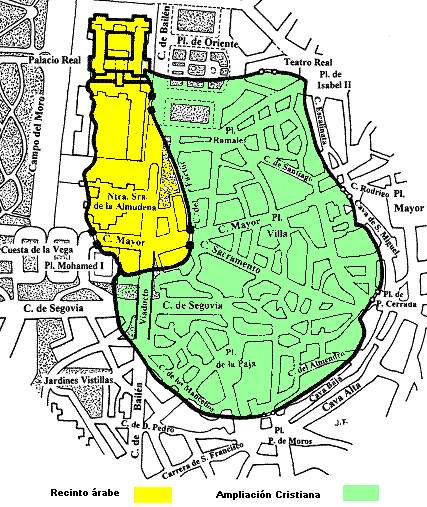
Although the original Muslim and Christian walls have practically disappeared, the concept of allowing or forbidding entrance through a gate has survived until these days. From the three original Muslim gates (Puerta de la Vega, Puerta de la Mezquita, Puerta de la Sagra) to the mostly symbolic arches of the 20th century gate (Puerta de la Ilustración), Madrid has built and destroyed numerous gates in its ever expanding territories. From all the current gates in Madrid, probably most iconic are Puerta de Alcalá, Puerta del Sol, and Puerta de Toledo. Nowadays Madrid gates, rather than obstacles controlling entrance, are popular city monuments.
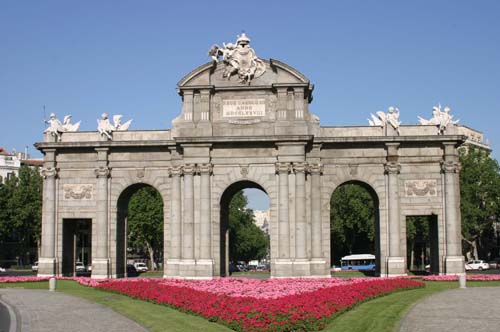 Puerta de Alcala in Madrid
Puerta de Alcala in Madrid
In the next few centuries the buildings and population of Madrid grew considerably and by the end of the 15th century it had a lively commercial activity that had attracted the attention of the Spanish royals. But how and when did Madrid become the capital of Spain? At a time when moving around was not that easy, Madrid is conveniently situated in the geographical centre of the Iberian Peninsula. It became politically important in 1561 when Philip II decided to move the royal court from Toledo, although when his son came to power, the court moved to the northwest, to the city of Valladolid, for a 5 year period (1601-1606). Since then Madrid was established as the primary political, economic, and cultural centre of the country.
The wordless anthem
National anthems are official symbols that enable people to identify themselves with a nation through music and language.
It is no surprise that the Spanish people started to get familiar with their current anthem during the 18th century. This was the time when Madrid, a prosperous capital city, erected a new Royal Palace for Charles III as well as many other distinctive monuments and gardens. It was also the time of the creation of libraries and Royal Academies (of the Spanish Language, History, Fine Arts), among other cultural institutions. Spain was in a creative national mood.
As with other patriotic symbols, there is some debate around the origin of the Spanish national anthem. Some have pointed out similarities with the Hispano-Arabic music of Ibn Bayyah as well as with some of the music heard in the time of Ferdinand of Aragon; others have claimed that the march came from Frederick the Great. What we do know from historical records is that in 1770 Charles III of Bourbon declared a military march, Marcha de los Granaderos, by the composer Manuel de Espinosa, as the music to be played at official events.
Click here to listen to the marchVideo player: Marcha_Real-Royal_March_by_US_Navy_Band.ogg
However, later on the march was to be replaced by another hymn (Himno de Riego) on three occasions, including the periods of the First Republic (1873-1874) and Second Republic (1931-1939). In fact, this hymn became historically the first legal anthem in Spain in 1820 but the present march always managed to return, finally getting its current sound and official status as national anthem in 1997.
History goes that it was not the monarch, but the Spanish population who called it Royal March (Marcha Real) and adopted it as the hymn for their nation despite that it was simply that, a military march without lyrics, a march that no one could sing. This preference was confirmed in 1853 when Queen Isabella II declared it national anthem. It was the first time the march was official recognised as a symbol for the Spanish nation. Since its adoption, different popular competitions and literary attempts have failed to consolidate words for the Royal March. Spain’s national anthem remains wordless.
Displaying power
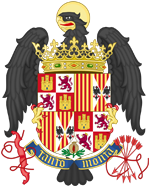 Ferdinand of Aragon and Isabella of Castile Coat of arms
Ferdinand of Aragon and Isabella of Castile Coat of arms
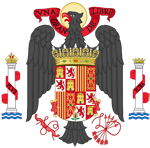 Coat of arms during the Franco Regime
Coats of arms are one of the distinctive demonstrations of royal power. In the history of Spain, one of the most powerful coats of arms was the one formed after the marriage of cousins Ferdinand of Aragon and Isabella of Castile. The design showed their arms combined, crowned and supported by the black eagle of Saint John. It also contained their personal symbols: a yoke (for Isabella) on the left, and a bundle of arrows (for Ferdinand) on the right. The motto “Tanto monta” (“They amount to the same”) meaningfully linking both symbols. Their arms were not fixed though. They suffered additions as they conquered first Spain, and then the world. This combination of identity items was highly successful impacting the design of all subsequent coats of arms in the history of Spain.
Coat of arms during the Franco Regime
Coats of arms are one of the distinctive demonstrations of royal power. In the history of Spain, one of the most powerful coats of arms was the one formed after the marriage of cousins Ferdinand of Aragon and Isabella of Castile. The design showed their arms combined, crowned and supported by the black eagle of Saint John. It also contained their personal symbols: a yoke (for Isabella) on the left, and a bundle of arrows (for Ferdinand) on the right. The motto “Tanto monta” (“They amount to the same”) meaningfully linking both symbols. Their arms were not fixed though. They suffered additions as they conquered first Spain, and then the world. This combination of identity items was highly successful impacting the design of all subsequent coats of arms in the history of Spain.
The coat of arms of the Catholic monarchs contained a message of Spain as a royal country in which various distinct parts had been united. In fact, their arms had a long revival during Francisco Franco’s dictatorship (1939-1975) with only minor changes in the overall presentation of the arms. Most distinct were the addition of the motto behind the eagle’s neck “Una grande libre” (“One, Great and Free”) as well as the Pillars of Hercules that Charles I had incorporated to his imperial version of the arms.
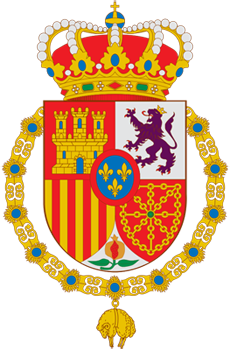 Coat of arms of King Philip VI of Spain
Today, the Royal arms stamped on the Spanish flag, replicates the representation of the Spanish old kingdoms (Castile, Leon, Aragon, Navarre, Granada) below the Royal crown. The current coat of arms also includes as central piece three fleur de lis of the House of Bourbon, and keeps the Pillars of Hercules with the traditional motto around them “Non plus ultra” (“Further beyond”).
Coat of arms of King Philip VI of Spain
Today, the Royal arms stamped on the Spanish flag, replicates the representation of the Spanish old kingdoms (Castile, Leon, Aragon, Navarre, Granada) below the Royal crown. The current coat of arms also includes as central piece three fleur de lis of the House of Bourbon, and keeps the Pillars of Hercules with the traditional motto around them “Non plus ultra” (“Further beyond”).
The reinventions of a flag
Shortly after the consolidation of the Christian kingdom, unified Spain became familiar with the Cross of Burgundy, which was typically a white flag with a red cross. This is considered the first flag of the Spanish nation and was used for more than two centuries by the Hapsburgs, but with the house of Bourbons, the flag experienced a radical transformation.
At the end of the 18th century, during the reign of Charles III, a new flag gets institutionalised in Spain. The king requested that the design of the naval flag be reconsidered, especially the colours used, so it could be easily spotted at sea. In 1785 horizontal red and yellow stripes were chosen for the flag. Charles III could not have predicted that his marine flag would consolidate as the symbol of the Spanish nation.
So successful was the new colourful flag that its use was extended by his son Charles IV to be visible on fortifications, and later on Isabella II requested that it should be adopted by the army. With more use and royal support, the flag got increasing recognition by the population. Again, as with the Spanish national anthem, it was Isabella II who eventually in 1843 made this flag official for the whole nation.
The Spanish flag was subsequently modified mostly by changes in the coat of arms. The most significant alteration to the design occurred during the Second Republic when its colours and shape were changed. The stripes got equal width and a new colour was introduced for the bottom stripe: murrey. Red and yellow were the traditional colours of the Crown of Aragon and murrey was chosen to represent Castile.
At present, each of the 17 different autonomous communities in Spain wave distinctive flags but the red and yellow flag with the Royal coat of arms remains the common one that represents the whole country.
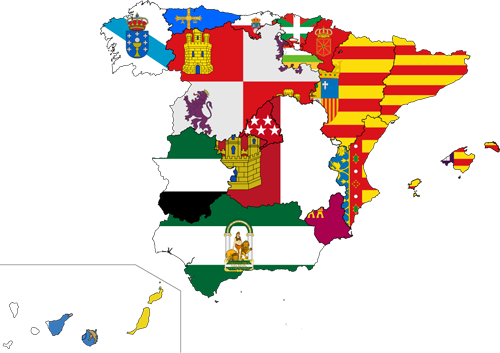
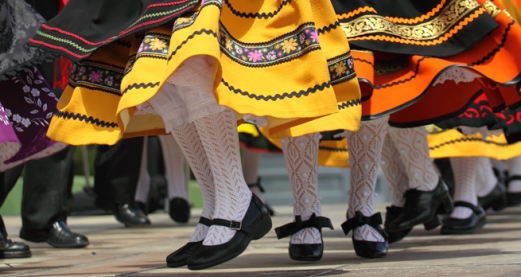
Rate and Review
Rate this article
Review this article
Log into OpenLearn to leave reviews and join in the conversation.
Article reviews